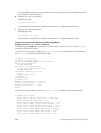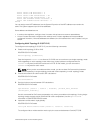
27
Intermediate System to Intermediate
System
The intermediate system to intermediate system (IS-IS) protocol that uses a shortest-path-first algorithm.
Dell Networking supports both IPv4 and IPv6 versions of IS-IS.
The IS-IS protocol standards are listed in the Standards Compliance chapter.
IS-IS Protocol Overview
The IS-IS protocol, developed by the International Organization for Standardization (ISO), is an interior
gateway protocol (IGP) that uses a shortest-path-first algorithm.
NOTE: This protocol supports routers passing both IP and OSI traffic, though the Dell Networking
implementation supports only IP traffic.
IS-IS is organized hierarchically into routing domains and each router or system resides in at least one
area. In IS-IS, routers are designated as Level 1, Level 2 or Level 1-2 systems. Level 1 routers only route
traffic within an area, while Level 2 routers route traffic between areas. At its most basic, Level 1 systems
route traffic within the area and any traffic destined for outside the area is sent to a Level 1-2 system.
Level 2 systems manage destination paths for external routers. Only Level 2 routers can exchange data
packets or routing information directly with external routers located outside of the routing domains. Level
1-2 systems manage both inter-area and intra-area traffic by maintaining two separate link databases;
one for Level 1 routes and one for Level 2 routes. A Level 1-2 router does not advertise Level 2 routes to a
Level 1 router.
To establish adjacencies, each IS-IS router sends different protocol data units (PDU). For IP traffic, the IP
addressing information is included in the IS-IS hello PDUs and the link state PDUs (LSPs).
This brief overview is not intended to provide a complete understanding of IS-IS; for that, consult the
documents listed in Multi-Topology IS-IS.
IS-IS Addressing
IS-IS PDUs require ISO-style addressing called network entity title (NET).
For those familiar with name-to-network service mapping point (NSAP) addresses, the composition of
the NET is identical to an NSAP address, except the last byte is always 0. The NET is composed of the IS-
IS area address, system ID, and N-selector. The last byte is the N-selector. All routers within an area have
the same area portion. Level 1 routers route based on the system address portion of the address, while
the Level 2 routers route based on the area address.
The NET length is variable, with a maximum of 20 bytes and a minimum of 8 bytes. It is composed of the
following:
488
Intermediate System to Intermediate System


















